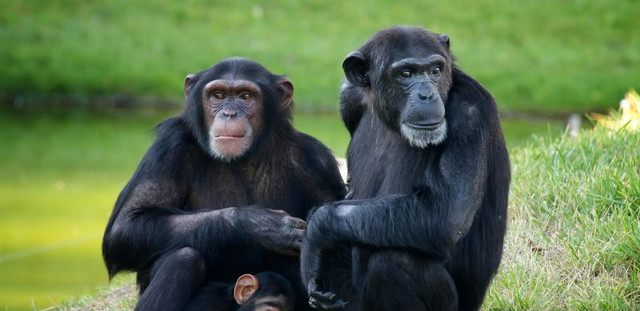News
Chimpanzees cannot learn a new language
They have “found the first evidence for vocal learning in a referential call in non-humans”, the behavioral psychologist Stuart K. Watson of the University of York and his co-authors mentioned in a publication earlier this year. In the study published in the journal Current Biology in February 2015, the scientists observed the integration of a group of chimpanzees from the Netherlands to an existing group in the Edinburgh Zoo. The researchers had found that the vocalizations of the Dutch animals converged towards the calls of the Scottish apes over time. Julia Fischer, ethologist at the German Primate Center, took a critical look at the data and drew a different conclusion. Particularly notable is the fact that the majority of the calls of the Dutch animals did not differ from those of the Scottish. This is rather an indication that the structure of the vocalizations of apes and monkeys are largely innate and can to a very limited extend, be modified. In addition, it cannot be ruled out that the new animals were initially simply more excited. Together with her colleagues, the behavioral researchers Brandon C. Wheeler and James P. Higham, Fischer has written a review of the study, which has now been published in the latest issue of Current Biology.
The two groups of chimpanzees were observed from 2010 to 2013 in Edinburgh Zoo. One group had been kept in the facility for several years, while the other group recently arrived from the Beekse Bergen Safari Park in the Netherlands. The scientists, led by Stuart K. Watson, watched the chimpanzees from both groups and recorded the characteristic grunts the apes made when they were given apples. According to the authors, the vocalizations of the Dutch chimpanzees differed in the beginning from those of the animals from the Edinburgh Zoo. However, after a period of three years the vocalizations of both groups of apes have been converged. The scientists interpreted this as the first evidence that non-human primates can learn different “referential calls” for the same object such as an apple from their conspecifics. Since the ability to arbitrary label objects or events with distinct referential words is one of the key characteristics of language, the authors presented this result as an important insight into the evolution of human language.
Julia Fischer, head of the Cognitive Ethology Laboratory at the German Primate Center and her co-authors, Brandon C. Wheeler, behavioral ecologist at the University of Kent in Canterbury and James P. Higham, an assistant professor of anthropology at New York University, are of convinced by the results after the re-analysis of the data. “The study by Watson has two major weaknesses”, said Julia Fischer. “Firstly, the authors have insufficiently investigated the causes of the altered vocalization of Dutch chimpanzees and secondly, the calls of both groups were already very similar in the first place and did not change significantly over the three-year period.”
According to the authors of the review, the altered vocalizations of the Dutch chimpanzees could be due to changes in their emotional state throughout the entire period. “The Dutch chimpanzees may have given slightly different calls with respect to the apples”, James Higham explains. “This can be understood as an initial increase of excitement of the apes concerning the apples or simply a response to the new environment and other conspecifics. The different calls are then an expression of higher arousal due to their insecurity. This was not explicitly investigated by Stuart Watson and his colleagues.”
These circumstances may cause the changes in the vocalization of the chimpanzees. The fact is that the initial state of higher excitement may be transformed over time because the apes got used to being fed with apples at their new home. Thus, the calls of the apes can easily change. According to Julia Fischer and her co-authors, this cannot be understood as the learning of a new object-oriented language.
The second key point of criticism of the study is the interpretation of the results. A re-analysis of the data showed that the patterns of vocalization of both chimpanzee groups were similar at the beginning of the study. “Regardless of their provenance, the majority of the animals responded with same call type when apples were presented”, said Brandon Wheeler. “Only seven of the 20 analyzed calls of the new chimpanzee group showed higher frequency values than the call patterns of the chimpanzees from Edinburgh. In the third year of the study there were still five calls that sounded different. The changes over over a period of years were therefore not particularly noteworthy.”
According to the authors, the study by Watson does not provide new insights into the evolution of human language. “When the chimpanzees have really learned a new language, the differences would have been much clearer. Thus, the results are rather an indication that the calls of non-human primates are actually innate. Why else should most calls have been consistent from the beginning, at a time when the animals did not even know each other?”, Julia Fischer concludes.
Original publication
Fischer, J., Wheeler, B.C., Higham, J.P. (2015): Is there any evidence for vocal learning in chimpanzee food calls? Current Biology 25, R1028-R1029, DOI 10.1016/j.cub.2015.09.010


